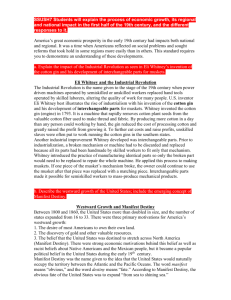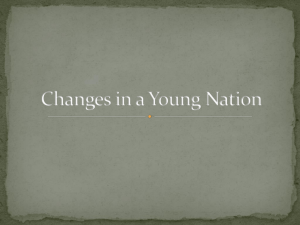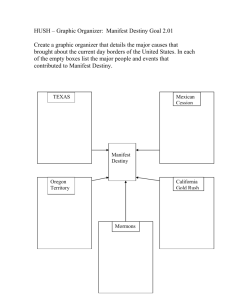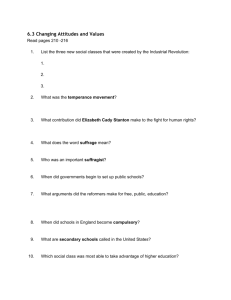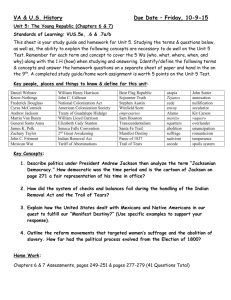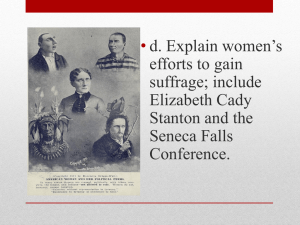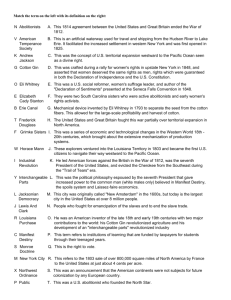unit 4: early expansion - Effingham County Schools
advertisement
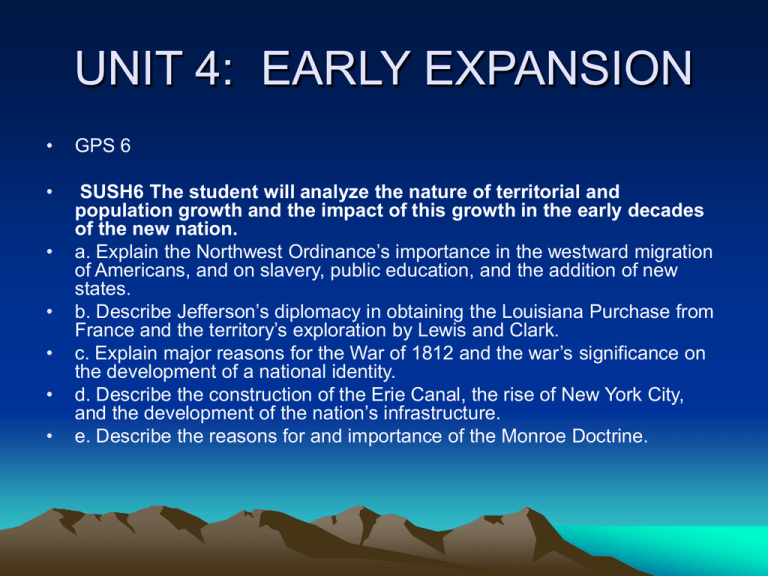
UNIT 4: EARLY EXPANSION • GPS 6 • SUSH6 The student will analyze the nature of territorial and population growth and the impact of this growth in the early decades of the new nation. a. Explain the Northwest Ordinance’s importance in the westward migration of Americans, and on slavery, public education, and the addition of new states. b. Describe Jefferson’s diplomacy in obtaining the Louisiana Purchase from France and the territory’s exploration by Lewis and Clark. c. Explain major reasons for the War of 1812 and the war’s significance on the development of a national identity. d. Describe the construction of the Erie Canal, the rise of New York City, and the development of the nation’s infrastructure. e. Describe the reasons for and importance of the Monroe Doctrine. • • • • • EARLY EXPANSION • • • • • • • GPS 7 SSUSH7 Students will explain the process of economic growth, its regional and national impact in the first half of the 19th century, and the different responses to it. a. Explain the impact of the Industrial Revolution as seen in Eli Whitney’s invention of the cotton gin and his development of interchangeable parts for muskets. b. Describe the westward growth of the United States; include the emerging concept of Manifest Destiny. c. Describe reform movements, specifically temperance, abolitionism, and public school. d. Explain women’s efforts to gain suffrage; include Elizabeth Cady Stanton and the Seneca Falls Convention. e. Explain Jacksonian Democracy, expanding suffrage, the rise of popular political culture, and the development of American nationalism. ECONOMIC EXPANSION AND RESULTS 1. INDUSTRIAL REVOLUTION 1)EARLY 1800S 2)POWER DRIVEN MACHINES DRIVEN BY UNSKILLED AND SKILLED WORKERS REPLACE HAND-DRIVEN EFFORTS INDUSTRIAL REVOLUTION • 3. SUMMARY: The Industrial Revolution was a period in the late 18th and early 19th centuries when major changes in agriculture, manufacturing, production, and transportation had a profound effect on the socioeconomic and cultural conditions in Great Britain and eventually spread to continental Europe, North America, and eventually the world. EXPANSION, INDUSTRIAL REVOLUTION (I.R.) • 4. ELI WHITNEY, BEST EX. OF IND. REV. • 1) INVENTION OF COTTON GIN • 2) INTERCHANGEABLE PARTS • 3) WHY IMPORTANT? DISCUSSION ELI WHITNEY • • Eli Whitney (December 8, 1765 – January 8, 1825) was an American inventor best known as the inventor of the cotton gin. This was one of the key inventions of the industrial revolution and shaped the economy of the antebellum South . Whitney's invention made short staple cotton into a profitable crop, which strengthened the economic foundation of slavery. Despite the social and economic impact of his invention, Whitney lost his profits in legal battles over patent infringement, closed his business, and nearly filed bankruptcy. ELI WHITNEY INTERCHANGEABLE PARTS 1. BUILDING OF IDENTICAL PARTS FOR MACHINES SO ONLY THE BROKEN PART WOULD NED TO BE REPLACE, RATHER THAN WHOLE MACHINE 2. APPLIED PROCESS TO BUILDING OF MUSKETS 3. RESULT: MASS PRODUCTION OF PRODUCTS MANIFEST DESTINY • Manifest Destiny is the historical belief that the United States was destined and divinely ordained by The God of Christianity ]to expand across the North American continent, from the Atlantic seaboard to the Pacific Ocean. Sometimes Manifest Destiny was interpreted so widely as to include the eventual absorption of all North America: Canada, Mexico, Cuba and Central America. It has also been used to advocate and justify other territorial acquisitions, as well as to justify the genocide of the Native American populations who were standing in the way of its believers and supporters. MANIFEST DESTINY • This painting (circa 1872) by John Gast called American Progress, is an allegorical representation of Manifest Destiny. Here Columbia, intended as a personification of the United States, leads civilization westward with American settlers, stringing telegraph wire as she travels; she holds a school book. The different economic activities of the pioneers are highlighted and, especially, the changing forms of transportation. The Indians and wild animals flee. REFORM MOVEMENTS DURING EXPANSION • • • • 1. TEMPERANCE 2. ABOLITION 3. PUBLIC SCHOOL 4. WOMEN’S SUFFRAGE TEMPERANCE • 1. ISSUE: PEOPLE SHOULD DRINK LESS; OUTLAW ALCOHOL • 2. IMPACT: • 1) MORE PROTESTANT RELIGIOUS INFLUENCE IN WEST AND RURAL AREAS • 2) ROLE OF WOMEN AND WOMEN’S MOVEMENT ABOLITION • 1. ISSUE: END SLAVERY; SHOULD NOT BE ALLOWED IN NEW STATES • 2. IMPACT: • 1) SLAVERY BECOMES POLITICAL ISSUE • 2) WOMEN SPEAK OUT…WOMEN’S MOVEMENT PUBLIC SCHOOL • 1. ISSUE: ALL CHILDREN SHOULD ATTEND FREE SCHOOLS SUPPORTED BY TAXPAYERS STAFFED WITH TRAINED TEACHERS. • 2. IMPACT • 1) EDUCATION WAS A RIGHT FOR ALL CHILDREN • 2) STATE AND LOCAL ISSUE • 3) IMPROVED SCHOOL QUALITY REQUIRING TRAINED TEACHERS WOMEN’S SUFFRAGE • 1. SUFFRAGE • 2. RIGHT TO VOTE • 3. ELIZABETH CADY STANTON, OUTSPOKEN ADVOCATE FOR WOMEN’S FULL RIGHTS (CITIZENSHIP, SUFFRAGE, CUSTODY-PARENTAL) • 1) 1848, SENECA FALLS CONFERENCE, 1ST WOMEN’S RIGHTS CONVENTION, NY • 2) ADOPTED A WOMEN’S DECLARATION OF INDEPENDENCE • 3) BEGINNING OF EQUAL RIGHTS MOVEMENT REFORM, SUFFRAGE • Elizabeth Cady Stanton (November 12, 1815 – October 26, 1902) was an American social activist and leading figure of the early woman's movement. • Her Declaration of Sentiments, presented at the first women's rights convention held in 1848 in Seneca Falls, New York, is often credited with initiating the first organized woman's rights and woman's suffrage movements in the United States. • ELIZABETH CADY STANTON PRESIDENT ANDREW JACKSON • PRESIDENT ANDREW JACKSON • Andrew Jackson (March 15, 1767 – June 8, 1845) was the seventh President of the United States (1829– 1837). He was military governor of Florida (1821), commander of the American forces at the Battle of New Orleans (1815), and eponym of the era of Jacksonian democracy. • An eponym is a person, whether real or fictitious, after whom a particular place, tribe, era, discovery, or other item is named or thought to be named. JACKSONIAN DEMOCRACY • 1. STRONGER PRESIDENCY AND EXE. BRANCH WITH WEAKER LEG. • 2. EXPANSION OF MALE SUFFRAGE TO ALL WHITE MALES, NOT JUST LANDHOLDERS • 3. POLITICIANS SHOULD BE ALLOWED TO APPOINT FOLLOWERS (FRIENDS) TO JOBS AS A WAY OF LIMITING THE POWER OF ELITE GROUPS. • 4. FAVORED MANIFEST DESTINY • 5. INCREASE IN PUBLIC PARTICIPATION IN POLITICS • 6. CAMPAIGN RALLIES AND BARBECUES JACKSONIAN DEMOCRACY • IN SUMMARY… • The Jacksonian era saw a great increase of respect and power for the common man, as the electorate expanded to include all white male adult citizens, rather than only land owners in that group. In contrast to the Jeffersonian era, Jacksonian democracy promoted the strength of the presidency and executive branch at the expense of Congress, while also seeking to broaden the public's participation in government. AMERICAN NATIONALISM DURING JACKSON YEARS • 1.MOVEMENT WHERE AMERICANS CONSIDERED THEMSELVES SUPERIOR TO OTHER NATIONS SINCE MOST WERE PROTESTANT AND SHARED ENGLISH LANGUAGE, ANCESTRY, AND CULTURE • 2.GOAL: EXPAND THIS CULTURE TO PACIFIC AND REMAKE NORTH AMERICA • 3. GO USA!!!!!!!
